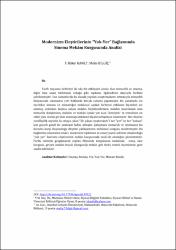Modernizm Eleştirilerinin "Yok-Yer" Bağlamında Sinema Mekânı Kurgusunda Analizi
Abstract
Tarih boyunca birbirleri ile sıkı bir etkileşim içinde olan mimarlık ve sinema, diğer tüm sanat türlerinde olduğu gibi toplumu ilgilendiren olaylarla birlikte şekillenmiştir. Son zamanlarda bu alanda yapılan araştırmaların artmasıyla mimarlık dünyasında sinemanın yeri hakkında birçok çalışma yapılmıştır. Bu çalışmada ise öncelikle sinema ve mimarlığın mekânsal açıdan birbirini etkileme biçimleri ele alınmış, ardından başlıca amacı mekânı biçimlendirmek, mekânı tasarlamak olan mimarlık disiplininin, mekânı ve mekân içinde yer alan “deneyim” in temsilinin en etkili yolu olarak görülen sinemayı etkileme biçimi tartışılmak istenmiştir. Her ölçekte yenilikçilik söylemi ile ortaya çıkan “20. yüzyıl modernizm”i her "yer" ve her "zaman" için geçerli genel bir yaklaşım halini almıştır. Çalışmada mimarlık ve sinemanın bu duruma karşı oluşturduğu eleştirel yaklaşımının mekânsal kurgusu incelenmiştir. Bu bağlamda çalışmanın amacı; modernist toplumun ve onun yaşam şeklinin oluşturduğu "yok yer" kavramı eleştirisinin mekân kurgusunda nasıl ele alındığını göstermektir. Farklı türlerde gruplanarak seçilen filmlerde kurgulanan mekânlar; tema, olay kurgusu, gerçek mekân–hayali (kurgusal) mekân gibi farklı temsil biçimlerine göre analiz edilmiştir. Being intensively interacted with each other architecture and cinema are shaped by the societal developments throughout the history as in the other kinds of art. With the recent increase in the research there have been conducted various studies analysing the role of cinema in architecture. This study, first, deals with the form of spatial interactions between film and architecture. Yet, the main objective of the article is to discuss in which ways the architecture aiming the form and shape the space influences the cinema that is seen as the most effective way to represent the space and the "experience” located in the space. Modernism of the 20th century that emerged with the discourse of innovation in all scales has become a general approach for every “place” and every “time”. In this study, spatial fiction of critical approach that architecture and cinema form against this situation is examined. In this regard, the purpose of the study is to demonstrate how critical of “non-place” notion that formed by modernist society and life style are handled. Cinema spaces, which are selected from films in different categories, were analysed according to different representation formats such as theme, event fiction, and real space–imaginary (fiction) space.
Volume
3Issue
1The following license files are associated with this item:


















